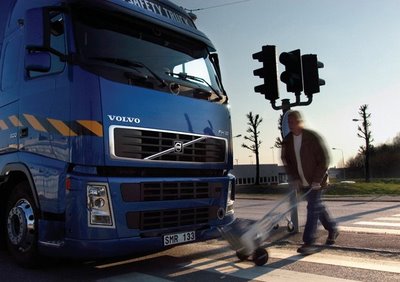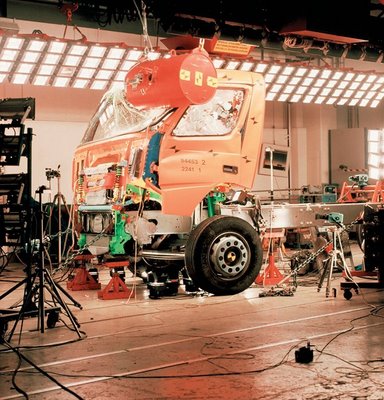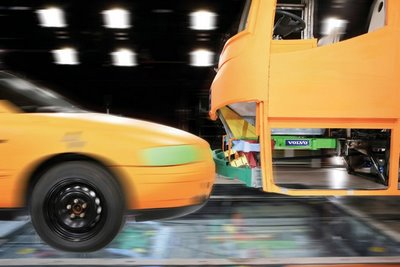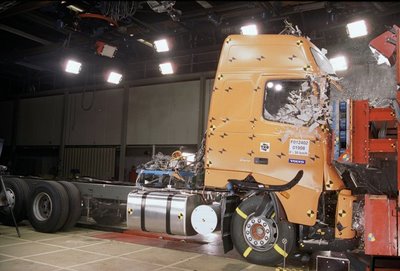 Safety on Indian roads is a most critical issue. With the growing vehicle population and expanding traffic on Indian roads, the issue, which has assumed serious proportions of late, needs to be addressed on a war footing. Almost 10-12 precious lives are being lost every hour on Indian roads leading to great social cost, besides mental agony and trauma for the close relatives of the victims.
Safety on Indian roads is a most critical issue. With the growing vehicle population and expanding traffic on Indian roads, the issue, which has assumed serious proportions of late, needs to be addressed on a war footing. Almost 10-12 precious lives are being lost every hour on Indian roads leading to great social cost, besides mental agony and trauma for the close relatives of the victims.
With the ongoing globalisation, India is fast emerging an economic superpower, and despite the present challenges in terms of rise in inflation caused by shooting fuel prices, the long-term road map looks promising. Mobility is basic for growth on sustainable basis, and with expanding economic activity, there is greater need for stepping up goods and passenger transport facilities.
A commercial vehicle owner / operator is always keen on minimising operational costs and maximising revenues. Almost 75 per cent of goods and 85 per cent of passengers are being moved by road. This throws up the biggest challenge in terms of safety and security as well as CO2 emission, air pollution and fuel shortage.
India has joined WP-29, the world forum for vehicle regulations harmonisation. This will make it necessary for the country to adhere to global safety and emission standards. This will also lead to local manufacturers adopting global standards and introducting advanced technological features as well as help in seamless integration of international regulations.
There are an estimated 90 million vehicles in India, of which 5 millions are commercial vehicles. For a very long time, Indian roads were ruled mostly by 2-axle: 4×2 trucks being manufactured and supplied by the leading CV majors, Tata Motors and Ashok Leyland. In the 1970s, Ashok Leyland introduced a range of multi-axle rigid truck and tractor-trailer models, Beaver / Hippo / Taurus, which were quite popular on Indian roads when it came to higher gross weight operations and ODC movements in India.
Demand for multi-axle trucks and articulated vehicles has been on the increase in the last five years. However, higher gross weight vehicles, increased mobility and higher vehicle speed have resulted in a large number of road accidents and fatalities.
More than 12 lakh persons die every year in road accidents worldwide. In India, the number of fatalities has crossed an alarming level of 1,00,000 per year. A detailed analysis cites several reasons for the growing road accidents in India. With almost 70 per cent of vehicular population being two-wheelers, it creates a non-homogenous mix of vehicles affecting smooth traffic flow. The large number of rail level crossings and the use of old vehicles are a major hindrance, besides road user’s behaviour, poor safety awareness among pedestrians, cyclists and two-wheeler drivers who are most vulnerable to accidents on Indian roads. Overspeeding, wrong overtaking and drunken driving, besides excessive truck and bus driver fatigue, add to the woes.
The Government and all stakeholders like vehicle manufacturers and automobile associations and institutions have been constantly addressing the issue of road accidents and fatalities and working out remedial measures. One of the recent initiatives in this direction was the setting up of the National Safety Board. Driver training, better traffic management, good roads, a road map for vehicular technologies, safety awareness campaigns, trauma care centres, etc., are some of the other initiatives taken to check the accident rate.
Swedish safety measures
Sweden has a long tradition of vehicle driving safety. The Swedish motor vehicle industry has achieved a world leading status in safety with the enforcement of strict road safety rules and adoption of high vehicle technologies. The guiding principle behind everything made at Volvo is safety.
According to Assar Gabrielsson and Gustaf Larson, founders of Volvo, technological features related to safety have two components: active safety and passive safety. ‘Active’ in simple term means all those features on vehicles which provide safety and minimise injury before the accident. ‘Passive’ refers to all those design features which provide survival space and minimise injuries after the accident.

Many firsts related to passive safety from Sweden are three-point seat belt (Volvo-1958), seatbelts as standard feature (Saab-1962), side impact protection (Saab, 1972), airbags for trucks (Volvo, 1994), world’s first side impact air bags (Volvo/Autoliv, 1995), front underrun protection system, (Scania, 1996), ISA/SRV/Aug 2008, inflatable curtain for side impact head protection (Volvo/Autoliv, 1998), first active head restraint (Saab, 1998), first anti-whiplash seat (Volvo/Autoliv, 1998), and whiplash protection system for rear-seat (Autoliv, 1999).
Current Technologies aim at saving lives through crash safety improvement features. Futuristic Trends will be aiming at moving the emphasis from passive to active safety systems with a focus on preventing the problems from arising and minimising traffic-related fatalities / injuries by developing smart technologies and new IT systems, roadholding and crash safety characteristics for cars and CVs; and intelligent vehicles and road infrastructure systems for users.
With this long safety tradition, Sweden has further consolidated its position by taking unique initiatives like the joint research unit for vehicle and traffic safety, world class collaboration to save lives, research conducted in areas like pre-crash, crash, post-crash and integrity safety, new competence center for vehicle safety systems and solutions, and industry-university co-operation to promote safety culture.
The Intelligent Vehicles Safety Systems (IVSS) programme is an ambitious plan in which the objective is to migrate from active systems to passive solutions. IVSS handles the driver errors effectively. The Vision Zero in Sweden is aimed at achieving zero fatalities and zero serious injuries on the nation’s roads.
CV cabin design features
The driver’s cabin manufactured and supplied by the Swedish majors, Scania and Volvo, have unique design and technology features with high tensile steel cage, steel bumper, front under-run protection system, large glass area with tilt for all-round visibility, large mirrors, excellent lightings, etc., to provide safety.

Some of the internal crash safety features for the cabin are energy absorbing steering wheel, fire-resistant trims and upholstery, knee level softness, stronger A-post, special pedals, adjustable seating systems, good ergonomic dash boards, convenient control positions, climate control and lower noise. These design features provide excellent passive safety in the event of an accident. Anti-lock brake (ABS) and electronic stability prog
ramme (ESP) are the additional features which will minimise accidents.
All manufacturers of truck cabins in Sweden design, manufacture and integrate the driver’s cabin on trucks so that they strictly meet the cabin safety standards. For the front end impact test, a pendulum weighing 1250 +/- 250 kg and made of 600 mm cylindrical shape (as per SS 2564 Type A) is used, and the cabin should meet 29.4 kJ impact energy levels. After the test, the driver’s cabin should remain intact on chassis, and all doors should remain closed.
As per Swedish regulation, vertical load of 147 kN is exerted on the roof of the cabin to test its strength and rigidity. After the test, the driver’s cabin should remain intact on chassis. All doors should remain closed, and there should be survival space created inside the cabin.
During the rear impact test, a pendulum weighing 1250 +/- 250 kg and made of 1600 mm x 500 mm rectangular shape (as per SS 2564 Type B) is used to exert impact at the rear of the cabin, and the energy absorption should be 29.4 kN per Ton of Vehicle mass. After the test, the driver’s cabin should remain intact on chassis. All doors should remain closed, and there should be survival space created inside the cabin for manikin created inside the cabin without any contact.
With a strong focus on safety, Swedish vehicle manufacturers have to meet an additional requirement called barrier crash test. Here full frontal collision is given for the truck without any offset and the vehicle travelling at 30 kmph speed under unladen condition. After the test, all doors should remain closed and the driver’s cabin should also remain intact on chassis.
The major difference between the ECE R29 and the Swedish test is that in ECE regulation the frontal impact energy level is 45 kJ, whereas in the Swedish barrier test the approximate level of energy is 260 kJ. All the tests are performed at the shortest and the longest cabin.
Indian CMVR & safety road map
Traditionally Indian CV manufacturers have been supplying either basic cowl or floor with front end structure for driver’s cabin on which various body builders would add rear walls, side walls and the roof to complete the cabin. In fact, cabins made of wood were also quite popular for a long time as they provided effective weather insulation during summer.
SIAM has been working very closely with all stakeholders to finalise a road map for automotive standards, including advanced safety features. Vehicle manufacturers have been following automotive industry standards which are generally in line with the ECE regulations.
In 2003, as a first step, India’s road safety journey started with various measures and technical features which included seat belts, lightings, rear view mirrors, improved braking systems, etc. Subsequently, by 2005, more regulations were introduced. In regard to specific safety standards for driver’s cabin in future, all CV cabins must be tested and type-approved for survival space as per AIS-29.
There are passive safety standards which define the requirements in terms of safety belts, seat belt anchorages, head restraints, fuel tanks, etc. The Automotive Industry Standards (AIS) Committee has been developing detailed technical requirements and standards for driver’s cabins as part of the truck body code to minimise the risk of injury for the occupants or the truck driver.
The AIS-29 is a standard which defines the requirements of survival space for protection of occupants of the cabin of Class N commercial vehicles used for goods transportation. Almost all major guidelines for AIS-29 are generally based on the ECE R-29 regulations. The important safety standards will be implemented from October next.
Similarly, AIS-031 relates to the superstructure strength of large passenger vehicles in which test methods have been defined for roll-over tests, pendulum tests, strength verification, etc.
AIS-029 and ECE R-29
During the test, the Manikin is used to verify the details. It is secured to the driver’s seat which is placed at the rearmost position. The cabin is fitted on the chassis.
In the front impact test, a swing bob made of 1500 +/- 200 kg steel and measuring 2500 x 800 mm flat plate is freely suspended, and it is made to strike front of the cabin. The impact energy is measured, and it should be 3,000 mKgf for vehicle of 7,000 mass. For a vehicle with GVW of more than 7,000 kg mass, energy absorption should be 4,500 Kgf.
The roof of the cabin should withstand a static load corresponding to permitted the front and rear axles and not exceeding 10,000 kg. The rear wall of the cabin should be capable of withstanding a static load of 200 Kgf per tonne of permissible useful load. Manikin is used for verifying the survival space.
Bus body code
India has seen a large number of bus body builders who have been fabricating and assembling bus bodies on regular truck chassis based on conventional designs and technologies. Subsequently many established bus body manufacturers entered the Indian market, like Irizar, Neoplan, Marcopolo, Volvo, etc.
